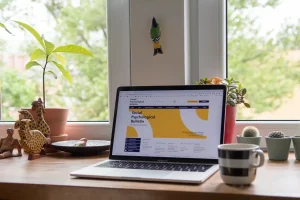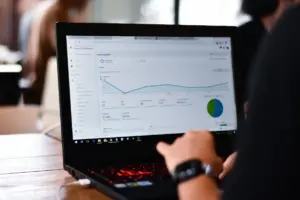How to Generate Backlinks – Complete SEO Guide
Are you looking to improve your SEO and appear in the first results of Google on your strategic keywords? Creating content optimised for SEO is not enough. You have to generate backlinks.
We will explain in detail the fundamentals of backlink building, why it is essential, how it works and where to start.
Discover all our methodological advice to generate backlinks and improve your SEO!
We like to see SEO as the same way a person or company has a reputation. A person with a good reputation is trusted, relied upon and gets a lot of referrals by word of mouth. SEO is the same thing (basically). When many trusted websites and platforms talk about your website, link to your website or create content about your website many things happen behind the scenes.
The main and end result is that Google amongst other search engines, notices and will start paying more attention to your website. It will then analyse your website, rank your blogs, services and most importantly your home page. The more this happens, the higher your rankings. The higher your ranking, the more calls and emails you get that are of higher quality and customers wanting to work with you.
Table of Contents
Toggle

Backlinks: how (and why) do they work?
The Web is a set of nodes and links. Links are at the heart of how the web works. These are the links that guide surfing to a large extent. If you visit a site that talks about something you love and the content you read is exciting and links to other content that allows you to “go further”, what is the probability that you will click on it? Admit it: if you like this site and trust it, it’s high enough!
Now let’s do a little thought experiment. Let’s say Google doesn’t exist. No search engine exists. Without search engines, how can we find the content we want. How to read articles about your passion, how to buy products online? You would use the links offered by sites that you already know that you appreciate and which you have complete confidence.
In the days when search engines weren’t as developed and sophisticated as they are today, links from resource pages or blog posts on websites were gold. And they still are. If a website has a link that points to your own website, it is the equivalent of a vote of confidence. Backlinks are an essential signal of relevance and quality of a web page, according to Google. This is why it is one of the main factors taken into account by the algorithm of the famous search engine. Result: backlinks have a big impact on SEO.
There is link and link. Not all links have the same quality, the same value. For Google, there are two main elements that are used to qualify the quality of a link:
The reputation, the reputation of the site which offers a link to your site. The authority of his field. On this subject, find out what the authority of a domain in SEO is, and why it matters.
The relevance of the link. If you’re a digital marketing agency for example, a link from a digital marketing media will be much more valuable than a link from a plumber site.
Relevance: the key concept of a successful link building strategy
Backlinks count. Google values them. It’s important to focus a bit on the notion of relevance, which is cardinal when we talk about backlink building.
Having a few seemingly irrelevant links will not have a negative impact on your SEO positions. Especially since some links qualified as irrelevant are not necessarily bad.
Let’s say you have a website selling hardware products. Suppose a sports blog links to your site. It is a link without any relevance, therefore little valued by Google. But if the blogger in question is writing a blog post about renovating his house, he has used your website to buy some of your favourite products and wants to share your site with his audience, the link is perfectly relevant. In other words, it is not relevant with regard to the site as a whole (a blog on sport), but it is relevant with regard to the context and the immediate environment of the link, i.e. blog article in which the blogger talks about renovating his house.
However, this type of link must remain in the minority. And, in general, it is.

Two Main Categories Of Relevant Backlinks
Backlinks from websites in your niche or in your industry.
Backlinks from websites linked to your geographic area: websites of companies that operate in the same region / city as you, websites of local associations, etc.
Obviously, it’s great to have backlinks from the Huffington Post or big news sites. But if these links have nothing to do with what you do, they may have less value than a link from a source that has less authority but is more relevant. And even if they have the same value, in any case they are extremely difficult to obtain … Hence the interest of concentrating these efforts on the two categories of backlinks listed above. You can try to target sites that are both very large and relevant, but it is often more interesting in the end to focus your research on small but relevant sites.
How To Generate Backlinks From Broken Links!
The different types of backlinks you can generate
There are different types of backlinks. Some are easier to generate than others. But links that are easy to generate are rarely the best …
Here are the main types of possible backlinks:
Backlinks from existing content – These are links that come from blog articles, pages or other content that has already been written and published. Example: you are reading a blog post on a topic that you have covered in depth on your own site. You contact the site’s webmaster to ask him to include a link to your site on his article.
Backlinks in new content – This is often called guest posting. This practice is not always well received, in part because it has been overused in the past. But in itself, there is nothing wrong with guest posting. On the contrary. The process is as follows: you identify a relevant website in relation to your own site, you offer the webmaster to write an article for free by putting a link to your website in the article. To succeed, read our article: “For guest blogging and backlinks, learn to whisper in the ear of bloggers”.
Resource Pages – Many blogs and websites have a resource page, which provides a list of links to “friendly” websites or at least sites that may be of interest to readers. The approach, to obtain this type of backlinks, consists simply in contacting the webmaster of the site to ask to be added to the list!
There are still other types of links, of course, but the ones we just presented are by far the most common. They are the ones you should focus on at the start.
We are going to present to you present the 4 steps to set up an effective backlinks strategy.
4 steps to generate backlinks
Step # 1 – Keyword research
You need to start by doing a keyword research to identify target queries and discover backlink opportunities.
The keywords are the queries you want to rank on Google. For example: “Find a plumber in Melbourne” or “buy cheap champagne”, or “SEO Services Melbourne“. You should also try to target “long tail” queries, such as: “specialised WordPress web marketing agency in Melbourne” or “find good value for money plumber in Australia”.
Find out why and how to work long tail keywords
But to find out what your target is actually typing in their search bar when they are looking to access the services or products you market, you need to do some research. Finding the keywords is really an important step. For this, you can use tools like Keyword Planner or use the website https://Keyword.io.
This preliminary keyword research will allow you to identify the websites, blogs, pages, articles, content from which to build and execute your backlinks building strategy.
20 Tools To Find Keywords With High Potential
Step # 2 – Create “linkable” content
You must create quality content for other websites to have the idea / agree to share it to their audience in the form of a backlink.
It is unlikely that a webmaster will agree to offer you a backlink to your product pages, your category pages or even your home page. Why? Because most of the time, these pages do not offer objectively interesting or useful content for readers of other websites. Of course, this is not always the case. We must not generalise. Maybe your homepage is a gateway to tons of useful resources and a webmaster will gladly link to it. But, in the real world, it almost never happens.
So rather than praying for a charitable webmaster to link to your home page or product page, you need to create “linkable” content, that is, high quality, useful content, exciting, very worked. These are “non-promotional” content.
Here are some examples of linkable content:
- Resource pages / link lists
- Online tools
- Videos
- Infographics
- The interviews
- The lists (X reasons for…, Top 10 tools, Selection of 15 recipients…, The 100 best films of all time…)
- The photo galleries
- In-depth studies
- Humorous content
- Complete guides
- The cards
- Tutorials
- Reviews / opinions on a product, on software, on a service
- Personal stories.
To be linkable, content must always either be entertaining or informative. Ideally, both! It has to be engaging content that you want to click on, that you want to read for fun and / or to learn useful things.
Obviously, creating linkable content takes time and consumes resources. It’s an investment. But it’s a profitable investment! And anyway essential. Without linkable content, link building is a losing battle. It’s in your best interest to start producing high-quality content before you spend money on link building campaigns.

The Ultimate Method To Get Quality Backlinks For Free
Step # 3 – Searching for backlink opportunities
Once you have your keywords, you need to identify backlink opportunities, i.e. target websites, i.e. sites where you would like to see a backlink to your own site.
It has to be relevant websites, as we saw above. Relevant either to your niche / industry or to your geographic location.
We advise you to list all these sites in a spreadsheet, in a column: the site name, the url, the contact email and the contact date.
This prospecting work takes time, it is certain, but it is one of the most interesting and cool stages of the process. You’ll find sites you’ve never heard of. To find the target sites, you have Google. If you are an interior design company, you can type searches such as “interior design blogs”, “interior design blog”, “interior design resources”, etc.
Step # 4 – Making contact
Once you have identified the target websites, you should contact those sites. It can be bloggers, journalists, webmasters, in short, people who control the site.
You are going to have to ask them for a very simple thing: ask them for a link! It’s simple to formulate, but it’s actually the most delicate, the most complex part of the process. No one owes you a link. Never forget it. Webmasters, bloggers can do whatever they want with their site, with their blog. You can’t impose anything on them. It is for this reason that often requests for backlinks are ignored. And webmasters have often been drowned for years in requests for unworked backlinks, which amount to spam. We can understand their reaction to ignore your requests.
The secret to having a success rate of 10% (which is very good): show them that it is worth it, that they have an interest in putting this link to your website. How? ‘Or’ What ? By showing them great content or showing them that the content you want them to share will appeal to their audience.
How to Generate Backlinks Tips
Generating backlinks is a long-term job, but it is a winning strategy. We cannot, today, have an SEO strategy that pays off without worrying about backlinks. To conclude, here are some tips:
- Do not be discouraged ! You are going to have a job, but you will be rewarded.
- Do not put all your eggs in one basket – try to create different types of backlinks (see above), diversify your approaches.
- Keep your spreadsheet up to date to know which sites you have contacted, when you have contacted them. It feels very bad to send the same prospecting email three days apart!
- Keep in mind that even good backlinks take time to have an effect on SEO.
- Keep learning about backlink strategies!




